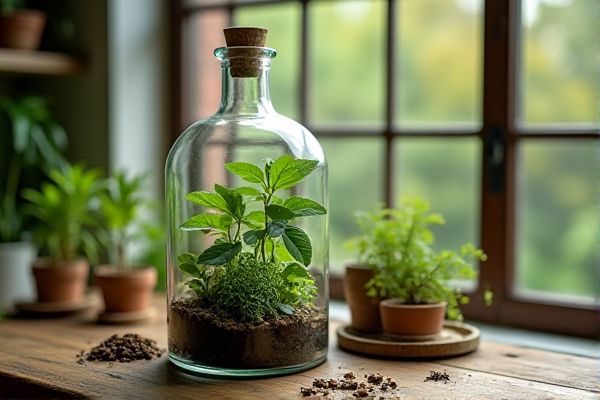
A bottle garden is a type of closed or semi-closed ecosystem typically housed in a repurposed glass bottle, creating a self-sustaining environment that requires minimal care, while a terrarium is a broader term encompassing various enclosed or open containers designed to grow plants, often focusing on decorative appeal and diversity. Explore the rest of the article to understand which option suits Your space and lifestyle best.
Table of Comparison
| Feature | Bottle Garden | Terrarium |
|---|---|---|
| Container Type | Sealed glass bottle | Open or closed glass container |
| Plant Types | Moss, small ferns, air plants | Succulents, tropical plants, moss |
| Maintenance | Low; rarely needs watering | Moderate; requires occasional watering and airflow |
| Environment | Self-sustaining ecosystem | Controlled microenvironment, varies by open/closed |
| Light Requirement | Indirect sunlight preferred | Depends on plant species; bright indirect common |
| Humidity Level | High humidity, sealed environment | Variable; open terrariums have lower humidity |
| Size | Generally small and compact | Varies from small to large |
| Aesthetic Appeal | Minimalistic, elegant | Decorative, diverse styling options |
Introduction to Bottle Gardens and Terrariums
Bottle gardens and terrariums are self-sustaining ecosystems enclosed within glass containers that create microclimates ideal for plant growth. Bottle gardens typically consist of sealed or partially sealed bottles hosting moisture-loving plants, relying on a natural water cycle, while terrariums can be open or closed environments featuring a wider variety of plants, including succulents and air plants. Both offer unique decorative and educational benefits, showcasing the principles of ecology in compact, manageable displays.
Defining Bottle Gardens
Bottle gardens are self-contained ecosystems sealed within glass containers, designed to sustain plant life with minimal care by recycling moisture and nutrients. Unlike terrariums, bottle gardens often feature a completely closed environment, creating a balanced microhabitat that mimics natural processes like evaporation and condensation. Your bottle garden thrives on this contained ecosystem, requiring little watering and offering a unique, low-maintenance way to showcase plants indoors.
What Is a Terrarium?
A terrarium is a transparent container, often made of glass, designed to house small plants and create a miniature ecosystem. Unlike bottle gardens that typically feature soil and plants sealed inside a bottle, terrariums offer better air circulation and often include decorative elements like rocks and moss. Terrariums support various plant types, including succulents and ferns, and can be either open or closed systems depending on moisture and light requirements.
Key Differences Between Bottle Gardens and Terrariums
Bottle gardens are self-sustaining ecosystems typically sealed within glass bottles, relying on a closed environment for moisture recycling, while terrariums can be open or closed containers that allow more airflow and require regular watering. The key differences lie in their design and maintenance: bottle gardens function almost autonomously with minimal intervention, whereas terrariums demand periodic attention to prevent mold and ensure plant health. Material choice also varies, with bottle gardens favoring narrow openings to maintain humidity, and terrariums utilizing wider or open tops to support a broader range of plant species.
Plant Selection: Bottle Gardens vs Terrariums
Bottle gardens typically house moisture-loving plants like ferns and mosses that thrive in sealed environments, creating a self-sustaining ecosystem. Terrariums offer greater versatility, accommodating succulents, cacti, and air plants that require more airflow and less humidity. Your choice depends on the plant species' humidity and light needs, ensuring proper growth in either enclosed bottle gardens or open terrariums.
Container Types and Materials
Bottle gardens typically use narrow-necked glass bottles that limit airflow and retain moisture, making them ideal for humidity-loving plants. Terrariums often feature wider containers made from glass or acrylic, allowing better ventilation and more diverse plant arrangements. Your choice between a bottle garden and a terrarium depends on the plants' requirements and the container materials' impact on light diffusion and moisture control.
Maintenance and Care Requirements
Bottle gardens require minimal maintenance due to their closed environment, which helps retain moisture and reduce the frequency of watering. Terrariums demand more frequent attention, including regular watering, pruning, and ventilation to prevent mold and ensure healthy plant growth. Understanding the care differences helps you choose the best option based on your available time and commitment to plant upkeep.
Aesthetic Appeal and Design Flexibility
Bottle gardens offer a minimalist, compact aesthetic with clear glass that highlights individual plants, perfect for small spaces and sleek decor. Terrariums provide greater design flexibility, allowing layered arrangements of soil, rocks, moss, and diverse plant varieties to create miniature ecosystems with intricate textures and colors. Your choice influences not only the visual impact but also how you personalize a green space to suit your interior style.
Common Uses and Applications
Bottle gardens commonly serve as low-maintenance decorative pieces ideal for offices and small living spaces, promoting air purification and aesthetic appeal. Terrariums often accommodate a diverse range of plants, including moisture-loving species, making them popular for educational purposes and botanical displays. Your choice between a bottle garden and terrarium depends on the desired plant variety and environmental control suited for your space.
Choosing Between a Bottle Garden and Terrarium
Choosing between a bottle garden and terrarium depends on your space, maintenance preferences, and plant types. A bottle garden is typically sealed with a narrow opening, creating a self-sustaining ecosystem ideal for moisture-loving plants, while terrariums offer open or closed environments with more air circulation, suitable for a wider variety of plants. Your decision should consider factors like humidity control, light exposure, and ease of access for watering and care.
 homyna.com
homyna.com